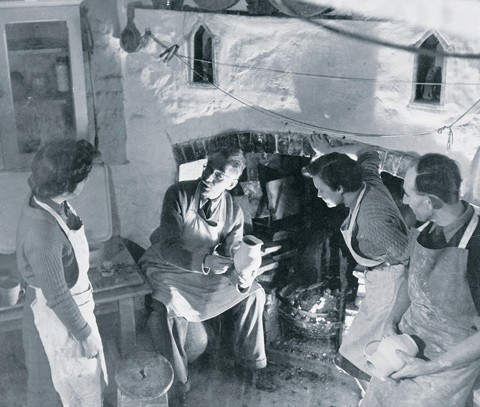
Bernard Leach, David Leach, and students at the Leach Pottery, St. Ives, Cornwall, ca. 1945. (Courtesy, Leach Archive, Crafts Study Centre, University for the Creative Arts.)
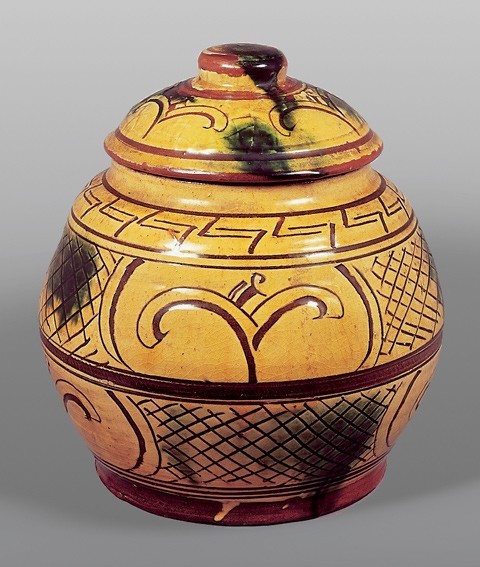
Bernard Leach, covered jar, 1924. Slipware. H. 9 7/8". (Ohara Museum of Art, Kurashiki, Japan.)
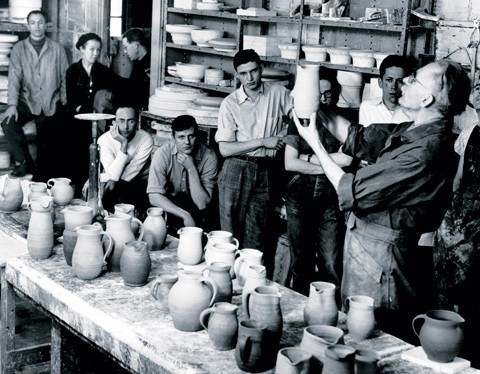
Bernard Leach discussing the merits of thrown pots with students at Alfred University, 1950. (Courtesy, College Archives, New York State College of Ceramics at Alfred University.)
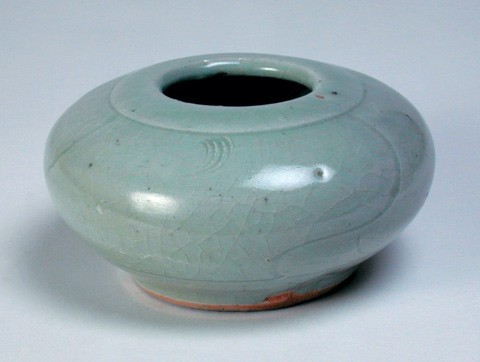
Bernard Leach, jar, St. Ives, Cornwall, ca. 1920–1948. Stoneware. H. 1 3/4". (Courtesy, Henry Bergen Collection, Potteries Museum and Art Gallery, Stoke-on-Trent.) Thrown and turned with a celadon glaze.
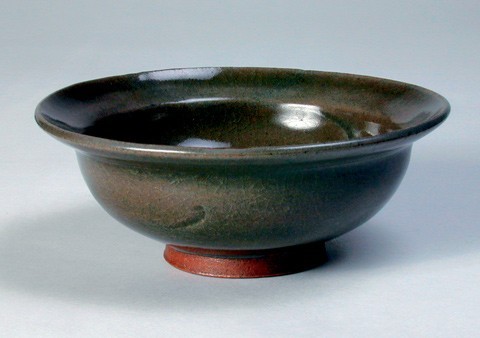
Bernard Leach, bowl, St. Ives, Cornwall, ca. 1920–1948. Stoneware. H. 1 3/4". (Courtesy, Henry Bergen Collection, Potteries Museum and Art Gallery, Stoke-on-Trent.) Thrown and turned with a celadon glaze.

Bernard Leach, mug, St. Ives, Cornwall, ca. 1920–1948. Stoneware. H. 4 7/8". (Courtesy, Henry Bergen Collection, Potteries Museum and Art Gallery, Stoke-on-Trent.) This is a so-called trellis mug with pulled handle and slip-trailed trellis decoration, and the word “ale” below.
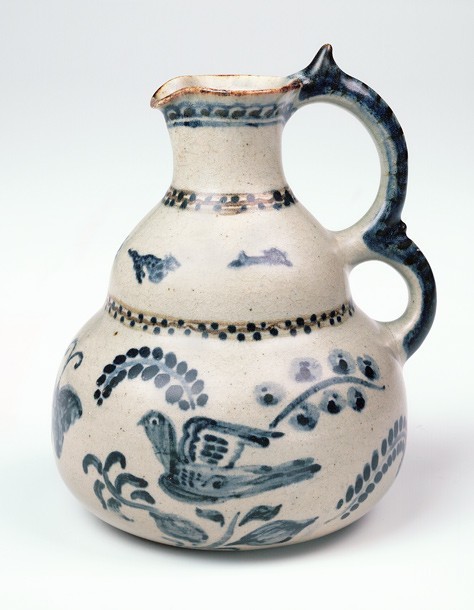
Bernard Leach, jug, 1912–1913. Stoneware. H. 5 5/8". (Courtesy, Leach Archive, Crafts Study Centre, University for the Creative Arts.)

Bernard Leach, bottle, St. Ives, Cornwall, ca. 1920–1948. Stoneware. H. 7 1/2". (Courtesy, Henry Bergen Collection, Potteries Museum and Art Gallery, Stoke-on-Trent.) Thrown with a pulled handle.

Warren MacKenzie, bowl, ca. 1969–1970. Stoneware. D. 6 1/4". (Courtesy, © Minneapolis Institute of Arts, www.artsMIA.org, gift of Rev. Richard L. Hillstrom.)

Left to right: Bernard Leach, Soetsu Yanagi, Shoji Hamada, and Teamaster Sato at Toyama, Japan, 1961. (Courtesy, Leach Archive, Crafts Study Centre, University for the Creative Arts.)

Bernard Leach, dish, St. Ives, Cornwall, ca. 1920–1948. Slipware. D. 13". (Courtesy, Henry Bergen Collection, Potteries Museum and Art Gallery, Stoke-on-Trent.)
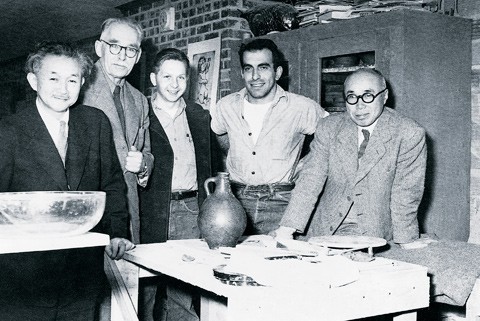
Workshop at the Archie Bray Foundation, 1952. Left to right: Soetsu Yanagi, Bernard Leach, Rudy Autio, Peter Voulkos, Shoji Hamada. (Courtesy, Archie Bray Foundation for the Ceramic Arts, Helena, Montana.)
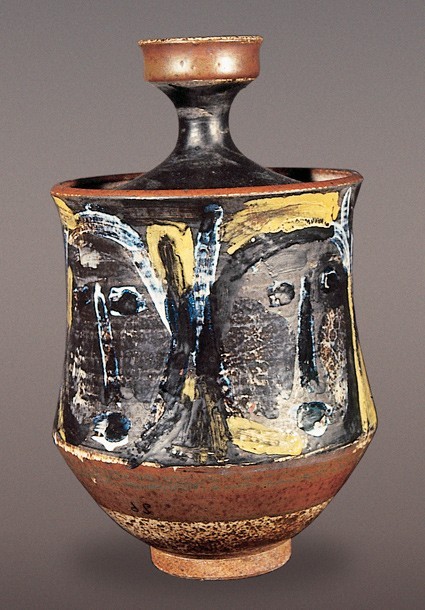
Peter Voulkos, covered jar, ca. 1954. Stoneware. H. 14". (Courtesy, Montana Museum of Art and Culture. Gift of Lela and Rudy Autio.) This jar was refired with low-fire imagery in 1958.
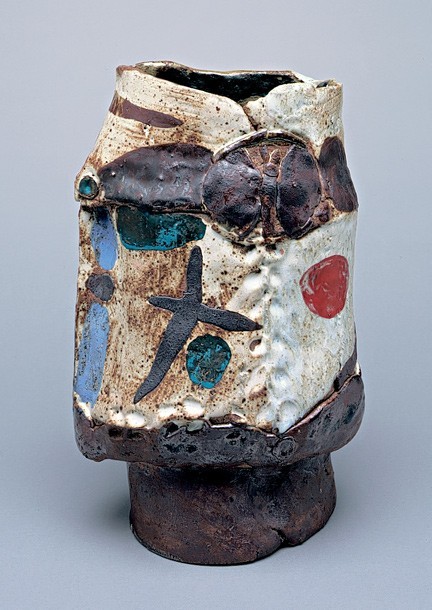
Rudy Autio, vessel, ca. 1965. H. 12". (Milwaukee Art Museum, Gift of Ruth and Robert Vogele, photo, John R. Glembin, acc. no. M2002.43.)
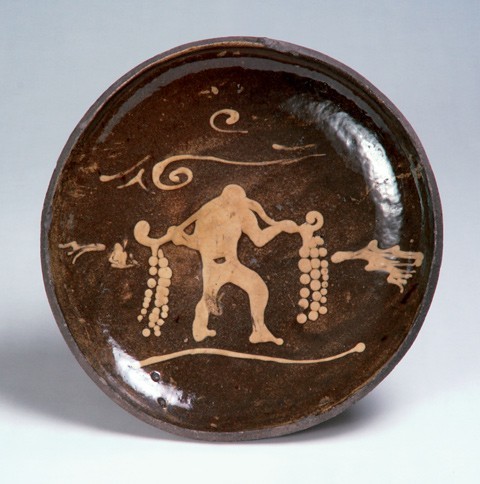
Bernard Leach, dish, St. Ives, Cornwall, ca. 1920–1948. Slipware. D. 13". (Courtesy, Henry Bergen Collection, Potteries Museum and Art Gallery, Stoke-on-Trent.)
Potter, artist, writer, poet, and one of the great figures of twentieth-century art, Bernard Howell Leach (1887– 1979) played a crucial pioneering role in creating an identity for artist potters in Britain and around the world.[1] After studying to be a potter in Japan in the early decades of the twentieth century, in 1920, with the help of Japanese potter Shoji Hamada, he set up his pottery at St. Ives, Cornwall (fig. 1). They built an Asian climbing kiln for high-temperature firing—the first in the West—and a small, round updraft kiln for earthenware and oxidized raku, introducing this technique to the West.[2] Alongside individual pots that were a synthesis of oriental and western infiuences (fig. 2), Leach first made tableware in earthenware and, later, with the help of his son David, in stoneware. A great admirer of Korean ceramics, Leach made important visits to Korea in 1918 and 1935. In 1934–1935 he toured and worked at country potteries in Japan, which further inspired his understanding of pottery. In 1940 he published his most important text, A Potter’s Book, which combined an aesthetic approach to appreciating pottery (advocating the “Sung standard”) with practical instructions on preparing clays, making pots, mixing glazes, and firing kilns.[3] Popular for its notion of the indivisibility of work and leisure in the life of a potter, the book rapidly assumed the status of a potter’s
In the postwar years Leach felt that he had a mission to travel and introduce his ideas abroad. In 1950, after a successful visit to Scandinavia the previous year, he embarked on the first of three major tours of America. All were concerned with presenting his work and ideas to potters, curators, enthusiasts, educators, and collectors. Although prewar exhibitions of his pots in the United States had met with little success, Leach was encouraged by visitors to St. Ives and, more particularly, by Robert Richman, director of the Institute of Contemporary Art in Washington, D.C., who arranged the itinerary. An ambitious ten-week lecture and demonstration tour was planned, spanning twelve thousand miles and including about one hundred seminars. Independently, an exhibition of 200–300 of Leach’s pots toured to various museums.
In February 1950 Leach set sail on the much-lauded brand-new liner SS Ile De France. His first major stop was at Alfred University, New York State College of Ceramics, the leading institution for both industrial and studio techniques, where Charles Harder (1889–1959) had arranged a full program of practical sessions in the morning and talks and lectures in the afternoon (fig. 3).[4] Most members of the predominantly male student body, however, had served in the war and, wanting to get on with their own projects, did not take kindly to the disruption, though they did enjoy Leach’s comments on their thrown pots.[5] He also introduced raku.
The visit was a mixed success. Some thought he spoke directly about their work, about the pleasure of the well-made object, and about the quietness and contemplative qualities of high-fired wares within an oriental aesthetic (fig. 4). Many, however, were more attracted by colorful Scandinavian pots and the ideas of the Bauhaus, and did not see his ideas as having much relevance. Nevertheless, he was able to convey the concept of wholeness, particularly the idea that “the pot is the man.”
Leach was greatly honored when the American Ceramics Society presented him with the Binns Medal for Ceramics, the highest such award in the country. The fact that the medal, usually awarded for industrial production, was given for his studio pottery tickled him.
Curious to see as much as possible, both by way of pots and institutions, Leach was pleased to be entertained in New York by Aileen Osborn Webb (1892–1979), a “tall, authoritative, yet strangely shy” figure who was a great patron of modern crafts and who combined a regal presence with genuine humility and an idealistic commitment to the crafts.[6] She helped to found the American Crafts Council and served as chairman of its board of managers; she also served as director of the School for American Craftsmen and was president of the American Craftsmen’s Cooperative Council, Inc., which published the magazine Craft Horizons. Her enthusiasm was in sharp contrast to Leach’s experience in England, where private patronage was modest at best.
For Leach, the biggest challenge was in trying to conceal his disapproval of the pots he saw on his tour. He soon missed the “old, tap-rooted inbred intimacies of a small country,” and described the United States as the “land of money and speed and gadgetry.” Whether in Washington, D.C., San Francisco, or New York, he was not averse to speaking his mind on the subject of pots—often with more than a hint of missionary zeal.[7] The pieces he saw, in his opinion, were often badly conceived. One example, a round, full, balloonlike shape with a tiny neck, a form that was made by several potters in different variations, stretched the shape to the point of distortion. Practical criticisms included “handles which are obviously stuck on and do not grow from within as branches grow from a tree-trunk” and “jug lips which will not pour without dripping; teapot spouts which are either goiterous or camel-like; hollow knobs on covered pots which contradict the formal rhythms of the rest of the shape.”[8] These observations confirmed his belief in the need for education and enlightenment.
By the same token, some American commentators were less than enthusiastic about Leach and his achievements. The innovative potter and teacher Daniel Rhodes (1911–1989), while acknowledging Leach’s importance in “turning the attention of potters to Chinese and Japanese values in pottery,” thought that in his own work Leach had not developed “a truly personal style, or a pottery which seems in keeping with any dynamic Western tradition” (figs. 5-8).[9] Despite this criticism, Leach,
In Minneapolis, where he gave lectures and demonstrations before fiying to San Francisco, Leach stayed with Warren and Alix MacKenzie, two potters who had visited him in St. Ives. An example of Warren MacKenzie’s pottery is illustrated in figure 9.
Leach also spent two weeks in Seattle with his old friend, fellow Bahá’í and abstract expressionist painter Mark Tobey and Tobey’s partner, Pehr Hallsten, an artist working in a naive style. In Tobey’s opinion Hallsten painted “wonderful attractive little paintings” and had “a remarkable natural color sense.”[10] Their relationship was a complex combination of love and aggression, in which affection was interspersed with much snarling and snapping. It was fully accepted by Leach, though to what extent he recognized its homosexual nature is not clear. (What he did find difficult was Tobey’s obsession with endless shopping expeditions, which left Leach so exhausted that at one point he sat on the pavement and demanded to be left alone.)
The Three Musketeers
In 1952 Leach, Shoji Hamada, and the Japanese critic and philosopher Soetsu Yanagi set out on a four-month coast-to-coast tour (fig. 10). Having held the highly successful International Craft Conference on Pottery and Weaving at Dartington in Devon, England, “the three Musketeers” (as they were dubbed by Leach in a letter to Lucie Rie) set sail for America in October on the SS Mauritania.[11] Their first stop was Washington, D.C., where they stayed with Robert Richman, and after sorting out a muddle over financial arrangements they traveled to their inaugural, two-week seminar at the experimental, interdisciplinary Black Mountain College in Asheville, North Carolina. At an elevation of 2,500 feet, the setting was magnificent. The mountains were clad in brilliant autumn colors, and black swallowtail butterfiies with their blue sheen fiitted amongst the trees and falling leaves, seemingly undisturbed by the great highways and fast traffic.
Thirty-five enthusiastic students and potters had enrolled in the program, which was to consist of films, slides, demonstrations, and lectures, as well as parties, excursions, and social events. All three lecturers quickly fell into roles they were to retain throughout the tour. Leach, the “articulator, the innovator . . . who coupled standards with form,” talked endlessly, gesticulated freely, and made a few pots.[12] Hamada, the doer, who “wrote in visual language” and who spoke only Japanese despite having good English, silently threw on the wheel and assembled a teapot in a matter of minutes. Yanagi, “the master of Zen aesthetics,” lectured on Buddhist theories of beauty and Zen and Shin—“the road of the few and the road of the many”—difficult concepts that often went over the heads of their audience.[13]
Three successful stoneware and earthenware firings were held. A high manganese glaze was used over black and white slips for the earthenware, and the stoneware body was enlivened by adding a local iron-bearing sand. One Leach pot, about seven inches tall, had a typical willow tree design (see, for example, fig. 11) incised through a dark slip under a white glaze.[14] The pieces produced by Leach and Hamada were sold for a total of $235, which the potters donated to the badly depleted college funds.
The twin themes of tradition and theory dominated discussions at Black Mountain—as they did, indeed, throughout the tour. With crusading passion Leach, Hamada, and Yanagi freely criticized attitudes to the craft as well as pots in an endeavor to enlighten, inform, and provoke. Although they stressed the need to understand rather than ape the broad base of their aesthetic ideas and philosophical approach, from the outset there was mixed response to their preference for soft, muted earth colors and harmonious shapes. Students seemed to prefer “recipes, tricks and dodges” over serious discussion about pots and pottery making. As a way of demystifying their approach, Hamada explained how attractive stoneware glazes could be made from combinations of rock and wood ash, and demonstrated how bundles of grass could be bound to make useful brushes.
The need for a tradition, or “tap root,” a topic articulated by Leach at great length two years earlier, was regularly discussed. “America as a new amalgam of races does not provide a craftsman with traditions of right making born on its own soil,” was Leach’s authoritative view.[15] Few students responded to such observations, and many dismissed his analysis as a failure to understand the nature of American culture. Susan Peterson, the potter in charge at the Chouinard Art Institute, Los Angeles, thought that “none of the three men could comprehend the melting pot nature of the United States.”[16]
At Black Mountain Leach’s most significant meeting was with the Texas-born potter Janet Darnell (1919–1997), for it was the start of a relationship that was to continue throughout his life. Having read and been impressed by the sense of wholeness and unity expressed in A Potter’s Book, and having heard Leach lecture two years earlier in New York, Darnell wanted to know more about his approach and philosophy. She traveled seven hundred miles from New York State to attend his workshop.[17] Strong-minded and determined, she had a clear vision of her needs and capabilities. With her striking angular features and a mop of dark, curly hair, she is remembered by Susan Peterson as “wiry, boney, thin with deep-set eyes . . . fun-loving and happy.”[18]
After Black Mountain the tour took Leach, Hamada, and Yanagi to Boston, Worcester, Ann Arbor, Detroit, St. Paul (again staying with the MacKenzies), and to the Archie Bray Foundation in Helena, Montana (fig. 12), where they met the gifted young potters Peter Voulkos (fig. 13) and Rudy Autio (fig. 14).[19] Voulkos, kicking the wheel for Hamada, admired his easy technique and relaxed brushwork, which he thought “rhythmical and dance like in movement and gesture.”[20] Visitors, however, were highly critical of Voulkos’s functional tableware for being too decorative. With a powerful sense of his own strong, simple forms but already concerned with pushing the boundaries of conventional craft, Voulkos was taken more by their ideas than by their opinion of his pots.
In search of American Indian pottery, Leach, Hamada, and Yanagi fiew to Santa Fe, New Mexico, to admire old handmade pots, woven and printed textiles, and genuine primitive Spanish religious paintings. At San Ildefonso they met the renowned potter Maria Martinez (1884–1980), who, when they found her, was raking pots out of the ash heap. Black and shiny from being fired with horse dung, the pots gleamed and sparkled and—for once—all three nodded their approval. For their lectures and demonstrations at the International Museum of Folk Crafts, Maria Martinez honored them by wearing her best blankets and necklaces of coral, jet, silver, and turquoise. Appropriately, Leach’s subject was the “Integration of the Craftsman,” a theme also taken up by Yanagi, who spoke on the “Responsibility of the Craftsman.”
Traveling around the countryside Leach marveled at the dramatic landscape—extinct volcanoes, ancient lava fiows, gigantic ramparts of rock, erosion, scrub, and slopes dotted with evergreen piñon—enthusing, “I have never seen a place which excited me more.”[21] The mile-deep, many-colored Grand Canyon was all they had imagined and appeared even more impressive under a light covering of snow. Its “scintillating opalescent light and incredible formations of ramparts, pinnacles, castles, bastions and slopes of water-worn rocks and far, far below glimpses of the thin thread of the Colorado River” for once overawed Leach.[22] Leach captured in a few deft lines the quality of the Arizona desert in a pen-and-ink wash (1952; Victoria and Albert Museum, London), evoking the vastness, heat, and drama of the landscape. The sepia-colored study contrasts with Snow and Pines, USA (1950; Mingeikan, Tokyo), a drawing in black ink wash that simplifies the hills and trees to great effect.
The final leg of their tour was Los Angeles and the Pacific Palisades, where Hamada stood on the cliffs gazing longingly over the Pacific toward Japan. The last stops were Scripps College, Claremont, and a two-week workshop with Susan Peterson at the Chouinard Art Institute. The audiences watched respectfully as Leach and Hamada threw several score of pots, ranging from modest marmalade jars to large urns. Again Hamada neatly assembled a teapot with a few rapid motions to an audience of one hundred students and four movie cameras. In San Francisco, as guests of the Japanese consul general, they stayed in his “posh and ugly” house overlooking the Golden Gate Bridge; the massive six-hundred-yard structure made a great impression. One remarkable night was spent at a snow-covered gorge in Yosemite to see the four-thousand-year-old redwoods, Sequoia gigantea, and the magnificent granite masonry of Half Dome.
While in California Leach and Hamada, both great admirers of the innovative American designer Charles Eames (1907–1978), visited him and his wife, Ray (1912–1988).[23] Eames’s openness to both hand- and machine work and his readiness—“open hearted, accepting and recreative”—to respond to East and West about furniture and design in general, successfully combined the traditional and the new. His radical molded fiberglass chair, exhibited to wide acclaim at the Museum of Modern Art, New York, seemed so far from Leach and Hamada’s handcrafted pots, both in spirit and appearance, that it is difficult at first to see the connection.
Accounts of their tour in Ceramics Monthly singled out Leach and Hamada’s unenthusiastic response to American ceramics, quoting Leach’s view that “strong digestive capacities” were required to absorb infiuences as diverse as pre-Columbian Indian and the contemporary abstract idiom, a feat that Leach thought few could achieve.[24] Various correspondents strongly rejected what they saw as the potters’ patronizing attitude. Far from respecting Leach’s work, one described his pots as “stuffy, heavy; and mid Victorian . . . and incredibly dull.”[25] In Craft Horizons Marguerite Wildenhain joined the many critical voices, contending that Leach and Hamada were starting from the wrong premise. Wildenhain insisted that to look for a single root was misconceived; the country had many cultures and, in fact, “lies its uniqueness, its grandeur.”[26]
The Third Visit
Leach’s third major visit to the United States, in 1961, was with his wife, Janet Darnell Leach, the potter he had met in America, got to know in Japan, and married in England in 1956. The trip was both a cementing of their relationship and an opportunity for talks, demonstrations, and sales. It was Janet who arranged their eight-week lecture and exhibition tour, which included seminars in thirteen different centers. They bought a large Ford station wagon, to allow for easier travel and to avoid expensive airfares, and Leach devised a scheme of first drawing and then making pots of a certain type so those sold could be replaced. At the suggestion of the Canadian potter John Reeve, then working in St. Ives, Leach read Dharma Bums, by the American beat writer Jack Kerouac, to give him an alternative view of the country.
The tour began with an exhibition at the small but exclusive department store Bonniers in New York. Meetings and events in the city ranged from public talks to what seemed like an endless round of dinner parties, including one at Aileen Webb’s handsome penthouse fiat. At the Museum of Indian Art they had lunch with the “sophisticated, but sincere, daughter of one of the Sioux chiefs and her American husband” and talked about pots.[27] More controversial was Peter Voulkos’s exhibition of painting and sculpture at the Museum of Modern Art. The large, bold, energetic sculptural pieces with their references to abstract expressionism, though technically skilled, were not to the taste of Leach and his wife, and they were convinced that had Voulkos made pots rather than semiabstract forms, his work would not have been shown at all. “Where has pottery failed this man?” Janet wondered.[28]
On two occasions they were invited to lunch by Miss Gordon, editor of House Beautiful, at the Four Seasons, thought to be the world’s most expensive restaurant, where “glass icicles fell from a heaven 50' above in cascades, the carpets were thick and silent, the food very good.”[29] Miss Gordon had “caught Zen and shibui” and, after devoting the August 1960 edition of the magazine to those ideas, wanted to hear more about them. “It astonishes me,” Leach wrote, “that a popular magazine in America should have the insight and courage to attempt to bring the austerities of Zen Buddhist taste to the multitudes of the West. Straw, straw, where blows thy wind?”[30]
As he had hoped, Leach discovered more about Janet and her life in America during this trip. They were received warmly at Threefold Farm, where she had worked as a potter, despite residual resentment at what some perceived as her disloyalty in abandoning the Steiner community.[31] From New York they went to Baltimore for a two-day stop to teach “29 nice, normal, eager beaver amateur but keen women students,” then drove 1,850 miles to Dallas and Grand Saline to stay with Janet’s parents and meet her relatives.[32] Although her mother disapproved of the marriage, she got on well with Leach, and he enjoyed watching Janet play dominoes with her father—both of whom, he noted, soon reverted to their private, well-established language.
“A lanky old man in a baggy tweed suit” was how a student in Dallas described Leach.[33] Leach proudly explained, however, that his outfit had belonged to his father, demonstrating his belief that the old was neither bad nor useless. He further impressed his audience by producing, prior to his demonstration, a handsome wooden lacquer toolbox “embedded with a sort of mosaic of colored bits of eggshells.”[34] Although well smattered with clay, the box possessed an element of finesse and style. During lectures he spoke enthusiastically about the work of potters like Cardew and Hamada and their awareness of tradition. This “warm, affable and opinionated potter-draftsman-philosopher” went over well, even when Leach told one would-be potter that his pot looked like “a top-heavy ballerina ”[35]
At the University of Michigan in Ann Arbor they stayed with Jim Plumer and interviewed an earnest young potter named Byron Temple (1933–2002), who had written for permission to work at Leach’s pottery.[36] At St. Paul they stayed with the MacKenzies, though Leach’s habit of treating them as students rather than mature potters continued to grate. He was particularly critical of what he saw as Alix’s lack of understanding of pattern. “Decor, rhythm, repeat pattern,” he pointed out, “are secondary to the pattern idea—the little dance—the little melody which picks up the form of a pot and completes it” (fig. 15).[37] Alix thought it typical of Leach that he made no effort to appreciate her experimental exploration
The ten-thousand-mile journey, which would have taxed a man half Leach’s age, was a success in most ways. Critical reception was respectful, although, as Janet observed, they did not “meet many of the leading potters,” and she could not help noticing that audiences tended to be enthusiasts rather than respected professionals.[38] Sales, however, were excellent, and Janet, on territory, felt at ease despite driving vast distances and making innumerable arrangements. She and Leach were together virtually without a break, and it seemed to work.
While many visitors may have found New York’s “man-made canyons of architecture” or the vast open spaces and huge distances daunting, for Leach they were a challenge, part of what he saw as “a crusade from coast to coast.”[39] And if the pots he saw failed to gain his approval, the people he found on all his visits were, almost without exception, polite and charming, generous in their hospitality, and greatly enthusiastic for the craft. Across the length and breadth of America he felt that he was met with every conceivable kindness, experiencing firsthand the life of prosperous Americans. But he did not accept America easily, suspicious of its modernity and consumer-oriented values. Janet, like many others, thought Leach made no real attempt to appreciate either the American way of life or their approach to making pots. But for many he spoke about values at a time of profound change, and, if not offering specific solutions, he did put forward a way of thinking about pots that was far from doctrinaire, and one that, as he often said, involved the “head, heart, and hand.”
Emmanuel Cooper is a potter, writer, critic, and editor of Ceramic Review: The International Magazine of Ceramic Art and Craft. This article is adapted from his biography of Bernard Leach, Bernard Leach: Life and Work (New Haven and London: Yale University Press, 2003).
When Leach took pots from the kiln he allowed them to cool rapidly in the open air. The glaze invariably crazed, but the colors were often bright. Post-firing reduction, a technique developed in America and one not used by Leach, was achieved by taking the pot directly from the kiln and placing it in an airtight container with a combustible material such as sawdust, leaves, or newspapers. The heat of the pot would cause the combustible to smoulder, resulting in blackened bodies and luster glazes.
Bernard Leach, A Potter’s Book (London: Faber and Faber, 1940).
Charles Harder, head of the design department, made salt-glazed domestic stoneware.
See Susan Peterson, “Refiections: Part 1—Leach at Alfred,” The Studio Potter 9, no. 2 (June 1981).
The American Crafts Council grew out of Aileen Webb’s efforts during the Depression. She was also involved with America House (est. 1940), the School for American Craftsmen, the Museum of Contemporary Craft (1956), and the World Craft Council (1964). For accounts of Aileen Osborn Webb, see Rose Slivka, “Our Aileen Osborn Webb,” Craft Horizons (June 1977): 10–13, and Rose Slivka, “Aileen Osborn Webb, David Campbell: A Reminiscence,” Craft Horizons (August–September 1993): 133–41.
Slivka, “Our Aileen Osborn Webb,” pp. 10–13.
Bernard Leach, “American Impressions,” Craft Horizons 10, no. 4 (winter 1950).
Daniel Rhodes, Stoneware and Porcelain: The Art of High Fired Pottery (1959; reprint, London: Pitman Publishing, 1978), p. 39.
Mark Tobey, letter to Bernard Leach, April 4, 1958, Leach Archive, no. 12239.
Bernard Leach, letter to Lucie Rie, November 4, 1952, Rie archives.
Susan Peterson, “Bernard Leach: Two Recollections,” The Studio Potter 8, no. 1 (1979– 1980): 3.
Bernard Leach, “The American Journey with Yanagi and Hamada,” n.d., private collection.
This piece is now in the collection of the Mingeikan (Japan Folk Crafts Art Museum), Tokyo.
Bernard Leach, A Potter in Japan (London: Faber and Faber, 1960), p. 34.
Peterson, “Bernard Leach: Two Recollections,” p. 3.
Leach, Potter’s Book.
Interview with the author, March 21, 1997.
The foundation had been set up by Archie Bray on the property of the Western Clay Manufacturing Company two years earlier to provide facilities and advanced ceramic studies within the state. Voulkos (1924–2002) was one of the most infiuential and significant potters of postwar America. Autio (b. 1926) remained at Archie Bray until 1956. Glenn Adamson’s review of Louana M. Lackey’s book Rudy Autio (2002) appears in this issue of Ceramics in America.
Quoted in Rose Slivka and Karen Tsujimoto, The Art of Peter Voulkos (Tokyo: Kodansha International, 1995). This was a turning point in Voulkos’s life, as shortly afterward he was invited to teach at Black Mountain College, where he came into contact with the ideas of the abstract expressionist painters. The connection stimulated him to produce more abstract sculptural forms in ceramics.
Leach, “American Journey with Yanagi and Hamada,” p. 6.
Ibid., p. 8.
The couple often worked as a team and together developed many ideas.
E. James Brownson, “Midwest Craftsmen’s Seminar,” Ceramics Monthly (March 1953): 10, 28.
Ceramics Monthly (March–April 1953); Leach Archive, no. 1728.
Marguerite Wildenhain, letter to the editor, Craft Horizons (May–June 1953): 43–44.
Bernard Leach, letter to Lucie Rie, March 16, 1960, Rie archives.
Janet Leach, “A Few Impressions of Current American Pottery,” Pottery Quarterly: A Review of Ceramic Art 7, no. 25 (1961): 12–16.
Bernard Leach, letter to Lucie Rie, March 16, 1960, Rie archives.
Bernard Leach, letter to Warren MacKenzie, March 16, 1960, private collection.
Rudolph Steiner (1861–1925) is the Austrian founder of anthroposophy. He evolved a study of spiritual concerns opposed to conventional occultism, and his educational theories of using the arts therapeutically were widely infiuential.
Bernard Leach, letter to Lucie Rie, March 16, 1960, Rie archives.
John P. McElroy, “A Visit from Bernard Leach,” The Studio Potter 27, no. 1 (December 1958): 18–19.
Ibid.
Ibid.
Byron Temple worked at the Leach Pottery from 1959 to 1962, and again from 1978 to 1979. He also made pots at Lambertville, New Jersey.
Bernard Leach, letter to Warren MacKenzie, May 16, 1960, private collection.
Leach, “Current American Pottery,” pp. 12–16.
Bernard Leach, letter to Lucie Rie, March 10, 1950, Rie archives.
